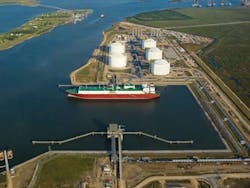EIA: U.S. Natural Gas and LNG Exports continue to grow through 2050
The Road to Net Zero notwithstanding, U.S. natural gas production and subsequent liquefied natural gas exports will continue to grow significantly over the coming decades, according to a recent long-term outlook by the U.S. Energy Information Administration.
The EIA’s report projects that domestic natural gas production could increase 15 percent to 42.1 trillion cubic feet (TCF) per year by 2050. The real driver of this sustained growth is not U.S. gas-fired power or heating demand, but a sharp growth curve in liquefied natural gas (LNG) exports.
Overseas demand for U.S. LNG could push exports to 10 TCF by 2050. Much of this volume will be met by production in Haynesville Formation and Permian Basin of the Gulf Coast and U.S. Southwest regions, respectively.
Those natural gas plays, revolutionized by a combination of directional drilling and hydraulic fracturing, are close to LNG infrastructure along the Louisiana and Texas Gulf Coast liquefaction and export terminals. Natural gas production is chilled to minus 260 degrees Fahrenheit (160 Celsius) which converts the gas form to a liquid state and makes it more stable for shipping.
Countries and companies from Asia, Africa and Europe, among others, are cutting long-term supply deals with U.S. LNG suppliers such as Cheneire Energy and others.
By 2050, according to the EIA, Haynesville gas production could exceed 12 trillion cubic feet annually, about 50 percent higher than current levels. The Permian Basin gas plays could yield a similar amount of annual output, the EIA graphic shows.
Natural gas is the top fuel resource for electric power generation in the U.S., accounting for close to 40 percent of the overall mix, according to the EIA. Coal-fired power still accounts for about 22 percent, far down from the one-time lead due to many plant closures as utilities pursue decarbonization goals.
Natural gas generation emits about half of the carbon dioxide of coal-fired power, according to reports. It also can be moved by pipeline to feed not only utility-scale generating units, but also on-site power and backup generators.
About the Author
Rod Walton, EnergyTech Managing Editor
Managing Editor
For EnergyTech editorial inquiries, please contact Managing Editor Rod Walton at [email protected].
Rod Walton has spent 17 years covering the energy industry as a newspaper and trade journalist. He formerly was energy writer and business editor at the Tulsa World. Later, he spent six years covering the electricity power sector for Pennwell and Clarion Events. He joined Endeavor and EnergyTech in November 2021.
Walton earned his Bachelors degree in journalism from the University of Oklahoma. His career stops include the Moore American, Bartlesville Examiner-Enterprise, Wagoner Tribune and Tulsa World.
EnergyTech is focused on the mission critical and large-scale energy users and their sustainability and resiliency goals. These include the commercial and industrial sectors, as well as the military, universities, data centers and microgrids. The C&I sectors together account for close to 30 percent of greenhouse gas emissions in the U.S.
He was named Managing Editor for Microgrid Knowledge and EnergyTech starting July 1, 2023
Many large-scale energy users such as Fortune 500 companies, and mission-critical users such as military bases, universities, healthcare facilities, public safety and data centers, shifting their energy priorities to reach net-zero carbon goals within the coming decades. These include plans for renewable energy power purchase agreements, but also on-site resiliency projects such as microgrids, combined heat and power, rooftop solar, energy storage, digitalization and building efficiency upgrades.

